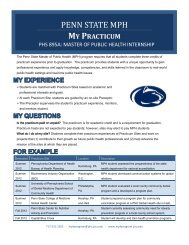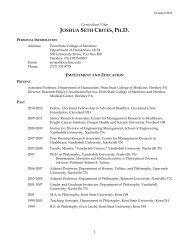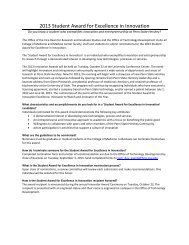Qualitative Data Analysis From Topics to Themes
Qualitative Data Analysis From Topics to Themes
Qualitative Data Analysis From Topics to Themes
You also want an ePaper? Increase the reach of your titles
YUMPU automatically turns print PDFs into web optimized ePapers that Google loves.
Ron ChenailNova Southeastern UniversityPenn State Hershey, College of MedicineMay 8, 2013
¨ What is qualitative data analysis?¨ How do I conduct qualitative data analysis andpresent results?
¨Generic Design is whenresearchers use genericor “eclectic” qualitativemethods (e.g., opencoding, axial coding,constant comparison) <strong>to</strong>produce conceptualcategories and themes.¨Designer Design iswhen researchers followdesigner or “namebrand” methodologies<strong>to</strong> produce the mosttransformed results andfindings (e.g., thickdescriptions, groundedtheories, essences oflived experience).
¨¨¨¨¨¨¨<strong>Qualitative</strong> <strong>Data</strong><strong>Analysis</strong><strong>Qualitative</strong> Content<strong>Analysis</strong>Thematic <strong>Analysis</strong><strong>Qualitative</strong> InterviewingEthnographicPhenomenologicalCase Study¨¨¨¨¨EthnographyGrounded TheoryPhenomenologyNarrative <strong>Analysis</strong>Discourse <strong>Analysis</strong>
¨ Words¨ Feelings¨ Actions¨ Rituals¨ Experiences¨ Perspectives¨ Impressions¨ Events¨ Artifacts¨ Symbols
¨ Interviews and Transcripts¨ Observations and Fieldnotes¨ Documents¨ Pictures and Images¨ Audio and Visual Recordings
¨<strong>Qualitative</strong> data analysis is the rigorousprocess of selecting qualitatively distinct data,articulating the qualitative meaning ascribed <strong>to</strong>those units, and commenting on the qualitativesimilarities and differences noted between andamong these distinct units of data.
¨The goal of qualitative data analysis can be <strong>to</strong>describe, explain, and/or interpretingqualitative patterns in terms of words,numbers, matrices, pictures, sounds, or otherforms of representation.
¨ Human thoughts are combinational (simpleparts combine)¨ Human thoughts are recursive (parts can beembedded within parts)¨ Human languages are combinational¨ Human thoughts about human languages arerecursive¨ <strong>Qualitative</strong> <strong>Data</strong> <strong>Analysis</strong> is a recursivecombining of simple steps
¨ Metaphoric: Saying some thing about something¨ Coding: Drawing a distinction and naming it¨ <strong>Analysis</strong>: Making sense of how thesedistinctions are qualitatively different andqualitatively similar
Relationship 1, 2, 3, & 4Relationship 1, 2, & 3Idea4Idea3Relationship 1 & 2Idea 2 Idea 1
Composite 1, 2, 3, & 4Composite 1, 2, & 3Case4Case3Composite 1 & 2Case 2 Case 1
¨ Discovery-oriented (i.e., typically moreinductive than deductive analysis)¨ Iterative (i.e., the process can be changed basedupon the outcomes)¨ Circular (e.g., constant comparison leading theresearcher from the analysis <strong>to</strong> the field andback again)
¨ Transformation from data, <strong>to</strong> information, <strong>to</strong>knowledge, <strong>to</strong> wisdom¨ Transformation from separation <strong>to</strong> connection(e.g., coding <strong>to</strong> create discrete nodes and thenconnecting the nodes <strong>to</strong> create categories)
Closest
¨ Presenting data as if they were the findings¨ Reproducing interview data, case his<strong>to</strong>ries, ors<strong>to</strong>ries they had collected in a reduced formwith minimal or no interpretation of those data¨ Containing no analysis and no interpretation(Sandelowski & Barroso, 2003, pp. 909-910)
¨ Emphasizing nominal or categorical data, orlists and inven<strong>to</strong>ries of <strong>to</strong>pics covered byresearch participants in interviews and focusgroups¨ Emphasizing inven<strong>to</strong>ries, frequencies, andpercentages of participants stating a <strong>to</strong>pic, orenumerations of the <strong>to</strong>pics themselves.¨ Investiga<strong>to</strong>rs often introducing <strong>to</strong>pics in theirinterview questions and/or derived from amanifest content analysis.(Sandelowski & Barroso, 2003, pp. 910-912)
¨ Conveying an underlying or more latentpattern or repetition discerned in the data¨ Containing the lowest level of abstraction¨ Offering more penetrating or nuanceddescriptions of experience, using either in vivoor everyday language, or themes or conceptsfrom existing empirical or theoretical literature<strong>to</strong> label and/or organize their data(Sandelowski & Barroso, 2003, pp. 912-913)
¨ Presenting one or more concepts or themeseither developed in situ from the data orimported from existing theories or literatureoutside the study¨ Moving <strong>to</strong>wards interpretively integratingportions of data¨ Extending the theoretical or other intellectualtradition from which they were imported and/or illuminating an experience(Sandelowski & Barroso, 2003, pp. 913-914)
¨ Transforming data <strong>to</strong> produce groundedtheories, ethnographies, or otherwise fullyintegrated explanations of some phenomenon,event, or case¨ Clarifying or elucidating conceptual orthematic linkages that re-present the targetphenomenon in a new way¨ Attending <strong>to</strong> relevant variations in both sampleand data (Sandelowski & Barroso, 2003, p. 914)
¨¨¨¨Target: The portion of the text that has caught yourinterestTag: The name you give <strong>to</strong> the target that reflects themeaning you ascribe <strong>to</strong> itTale: The s<strong>to</strong>ry of the tag’s meaning in relationship <strong>to</strong>the target in which you make the evidential qualities ofthe target in support of your tag overt.Thesis: The proposition that connects the patternsreflected across the tales of the tags’ relationships <strong>to</strong>their targets (Chenail, 2010)
¨ Generate and Analyze the <strong>Data</strong>¨ Bricoleur¨ Preparation¨ Stamina
¨ Systematic yet creative¨ Focused yet reflective¨ Testimonial yet evidential¨ Subjective yet objective
¨ Codes, Categories, and <strong>Themes</strong>¨ <strong>Analysis</strong> and Memos¨ Quality Control
¨ Articulating the relationship between meaningand data (Codes), Codes (Categories) andCategories (<strong>Themes</strong>)¨ Internal Integrity (i.e., Is there a high degree ofhomogeneity across the individual codes oracross the coded units within the categories?)¨ External Integrity (i.e., Is there a high degree ofheterogeneity or differentiation between thearray of homogeneous codes, categories, orthemes?) (Chenail, 2008)
¨ Exhaustive System of Codes, Categories, and<strong>Themes</strong> (i.e., No significant meaningful featureof the phenomenon under study falls outside ofthe array)¨ Dual Planes of Focus: Horizontality (i.e.,category-<strong>to</strong>-category relationships) andVerticality (i.e., category-<strong>to</strong>-phenomenarelationships) (Chenail, 2008)
Clip OneTranscription• Code One• Code Two• Code Three• Code FourClip TwoTranscription• Code One• Code Two• Code Three• Code Four
Clip OneCategoryACategoryBCode OneCode TwoCodeThreeCodeFour
Clip OneClip TwoClipThreeCategory ACategory ACategory ACategory BCategory BCategory BCategory CCategory CCategory C
CategoryAClip OneCategoryBClip OneCategoryCClip OneClip TwoClip TwoClip TwoClip ThreeClip ThreeClip Three
Theme OneCategory A(CodedClips One,Two, &Three)Category B(CodedClips One,Two, &Three)Category C(CodedClips One,Two, &Three)
¨ Making Sense of the Codes, Categories, and<strong>Themes</strong> in Context (i.e., Research Question andLiterature)¨ Shifting from Information <strong>to</strong> Knowledge¨ Asking yourself the question, “What have Ilearned?”
¨ Memos are notes in which we make themeaning of our codes, categories, themes, andanalysis transparent¨ Memos are the start of the analysis and theresults¨ Memos create our audit trails
<strong>Qualitative</strong> <strong>Data</strong> <strong>Analysis</strong>The ThisThe ThatCode, Category, Concept,TheoryUnit of <strong>Analysis</strong>
<strong>Qualitative</strong> <strong>Data</strong> <strong>Analysis</strong>The ThisDescriptive CodeThe ThatUnit of <strong>Analysis</strong>Clinical Problem: The therapistnoted the client reported comingin<strong>to</strong> therapy because she sharedhaving anxiety as her clinicalproblem, that is, a reason forwhich someone seekspsychotherapy.Client came in with anxiety…
<strong>Qualitative</strong> <strong>Data</strong> <strong>Analysis</strong>The ThisIn Vivo CodeThe ThatUnit of <strong>Analysis</strong>Anxiety: The therapist notedthe client reported coming in<strong>to</strong>therapy with anxiety.Client came in with anxiety…
¨ Instrumentation¨ Piloting¨ Transparency¨ Audit Trails¨ Constant Comparison¨ Member Checking¨ Peer or Expert Debriefing¨ Multiple Coders¨ Exemplars
¨ <strong>Data</strong> as Star¨ Juxtaposition¨ Exemplars for every assertion, pronouncement,or declaration (Chenail, 1995)
¨¨¨¨¨Compose your analytical memos so they couldbe cut and pasted in<strong>to</strong> the body of your reportName and explain/describe the qualitativedifference in full sentencesCopy and paste the data excerpt in<strong>to</strong> the memoExplain or describe how the data excerptexemplifies and evidences the meaning of yournoted qualitative difference (e.g., code, category,theme)Bot<strong>to</strong>m Line: Your analysis is your report!
¨ Hedging¨ Avoid Errors of Deficiency and Exuberance byStaying Close <strong>to</strong> the <strong>Data</strong>¨ Develop a Rhythm(Chenail, 1995)
¨ Restricting as in setting or qualifyingconditions relative <strong>to</strong> the results being reported<strong>to</strong> avoid extremes or limit meaning.¨ Fits with constructionist, constructivist,phenomenological, naturalistic, explora<strong>to</strong>ry,descriptive, interpretive, post-modern, andcritical research approaches
¨¨¨¨Propositions <strong>to</strong> express results for consideration andnot “results as the facts” by using “such as,” “may,” or“perhaps”Possibilities <strong>to</strong> express a likelihood or certainty ofresults and not “results as the truth” by using “seem,”“appear,” “suggest,” “speculate,” or “imply”Approximations <strong>to</strong> express quantity, frequency, degree,and time of results by using “generally,”“approximately,” “most,” “some,” “many,” “few,” or“frequently”Conditions <strong>to</strong> express co-dependent or local situationsor circumstances relative <strong>to</strong> results by reporting “who,”“what,” “where,” “when,” “why,” and “how”
Although the findings of this study arecompromised by the small sample size and itsvariability, they suggest in a very tentative waythat there may be subtle differences in the waychoice is perceived, "exercised and burdened" [50](p. 237) in the aftermath of the detection of fetalimpairment. (Sandelowski & Jones, 1996, p. 359)
Although a much larger sample is required <strong>to</strong>verify that these are distinguishable patterns ofemplotments of choice, one very tentativeconclusion that may be drawn from this finding isthat some external circumstances may permit agreater variety of narrative constructions thanothers. (Sandelowski & Jones, 1996, p. 359)
Although the findings from this study are verytentative and must be verified, they do raiseinteresting questions for future research.(Sandelowski & Jones, 1996, p. 359)Sandelowski, M., & Jones, L. C. (1996). ‘Healing fictions': S<strong>to</strong>ries of choosing inthe aftermath of the detection of fetal anomalies. Social Science & Medicine, 42(3),353-361.
¨¨Natural - The data are presented in a shape thatresembles the phenomenon being studied. Forinstance, if the data are excerpts from a therapysession, present them in a sequential order or inan order that re-presents the flow of the sessionitself.Most Simple <strong>to</strong> Most Complex - For sake ofunderstanding, start the presentation of datawith the simplest example you have found. Asthe complexity of each example or exemplarpresented increases, the reader will have abetter chance of following the presentation.Erving Goffman's work is a good example ofthis style.
¨ First Discovered/Constructed <strong>to</strong> LastDiscovered / Constructed - The data arepresented in a chronicle-like fashion,showing the course of the researcher'spersonal journey in the study. This style isreminiscent of an archeological style ofpresentation: What was the first "relic"excavated, then the second and so forth.
¨ Quantitative-Informed - In this scheme dataare presented according <strong>to</strong> strategiescommonly found in quantitative orstatistical studies. <strong>Data</strong> are arranged alonglines of central tendencies and ranges,clusters, and frequencies.
¨Theory-Guided - <strong>Data</strong> arrangement is governedby the researcher's theory or theories regardingthe phenomenon being re-presented in thestudy. For instance, a Marxist-informedresearcher might present data from a doc<strong>to</strong>rpatientinterview in terms of talk which showswho controls the means for producinginformation in the interaction, talk whichillustrates who is being marginalized, and soforth. In clinical qualitative research, thisapproach is quite prevalent as cliniciansorganize the data in terms of theirunderstandings of how doc<strong>to</strong>r-patient, ornurse-patient, and therapist-client interact.
¨ Narrative Logic - <strong>Data</strong> are arranged with aneye for s<strong>to</strong>rytelling. Researchers plot out thedata in a fashion which allows them <strong>to</strong>transition from one exemplar <strong>to</strong> another justas narra<strong>to</strong>rs arrange details in order <strong>to</strong> bestrelate the particulars of the s<strong>to</strong>ry.¨ Most Important <strong>to</strong> Least Important or <strong>From</strong>Major <strong>to</strong> Minor - Like the journalistic styleof the inverted pyramid, the most important"findings" are presented first and the minor"discoveries" come last.
¨¨Dramatic Presentation - This one is theopposite of the inverted pyramid style. With thedramatic arrangement scheme, researchersorder their data presentation so as <strong>to</strong> save thesurprises and unforeseen discoveries for last.No Particular Order Order - As it sounds, dataare arranged with no particular, consciouspattern in mind, or the researcher fails <strong>to</strong>explain how or why the data are displayed theway they are.Adapted from Chenail, R. J. (1995). Presenting qualitative data. The <strong>Qualitative</strong> Report, 2(3).Retrieved from http://www.nova.edu/ssss/QR/QR2‐3/presenting.html
¨¨¨¨¨¨List Section HeadingPresent the Distinction or FindingIntroduce the First <strong>Data</strong> Exemplar of this DistinctionDisplay the First <strong>Data</strong> Exemplar of this DistinctionComment on the First <strong>Data</strong> Exemplar as EvidenceMake Transition <strong>to</strong> Second <strong>Data</strong> Exemplar and Repeatthe Pattern Until the Closing of this Section
¨ Theme One¡ Introduce first category (i.e., Category A)¡ Introduce first exemplar (e.g., Category A’s CodeOne from Clip One)¡ Explain how the exemplar evidences a quality of firstcategory¡ Explain relationship between first category’squalities and the overall theme’s qualities¡ Introduce additional exemplars for first category¡ Explain how each evidences a different quality ofCategory A¡ Transition <strong>to</strong> second category
¨Theme One¡ Introduce second category (i.e., Category B)¡ Introduce first exemplar (e.g., Category B’s Code Onefrom Clip One)¡ Explain how the exemplar evidences a quality of secondcategory¡ Explain relationship between second category’s qualitiesand the overall theme’s qualities¡ Introduce additional exemplars for second category¡ Explain how each evidences a different quality ofCategory B¡ Transition <strong>to</strong> additional categories, conclude Theme One,and transition <strong>to</strong> Theme Two
¨ Theme Two¡ Repeat
¨ Maintain Coherence and Build Confidence¨ Stay Focused on the Research Question¨ The Role and Place of the Literature
¨ Chenail, R. J. (1995). Presenting qualitativedata. The <strong>Qualitative</strong> Report, 2(3). Retrievedfromhttp://www.nova.edu/ssss/QR/QR2‐3/presenting.html¨ Chenail, R. J. (2008). Categorization. In L. M.Given (Ed.), The SAGE encyclopedia of qualitativeresearch methods (Vol. 1, pp. 72-73). ThousandOaks, CA: Sage.
¨ Chenail, R. J. (2010). How <strong>to</strong> read and review abook like a qualitative researcher. The<strong>Qualitative</strong> Report, 15(6), 1635-1642. Retrievedfrom http://www.nova.edu/ssss/QR/QR15-6/readreview.pdf¨ Sandelowski, M., & Barroso, J. (2003).Classifying the findings in qualitative studies.<strong>Qualitative</strong> Health Research, 13(7), 905-923.
¨¨Chenail, R. J. (2012). Conducting qualitative dataanalysis: Reading line-by-line, but analyzing bymeaningful qualitative units. The <strong>Qualitative</strong> Report,17(1), 266-269. Retrieved fromhttp://www.nova.edu/ssss/QR/QR17-1/chenailline.pdfChenail, R. J. (2012). Conducting qualitative dataanalysis: <strong>Qualitative</strong> data analysis as a metaphoricprocess. The <strong>Qualitative</strong> Report, 17(1), 248-254.Retrieved from http://www.nova.edu/ssss/QR/QR17-1/chenail-metaphor.pdf
¨ Chenail, R. J. (2012). Conducting qualitativedata analysis: Managing dynamic tensionswithin, part one. The <strong>Qualitative</strong> Report, 17(T&LArt. 4), 1-6. Retrieved fromhttp://www.nova.edu/ssss/QR/QR17/chenail-tensions.pdf
¨ Online QDA:http://onlineqda.hud.ac.uk/index.php¨ The <strong>Qualitative</strong> Report:http://www.nova.edu/ssss/QR/¨ Graduate Certificate in <strong>Qualitative</strong> Researchhttp://www.nova.edu/ssss/QR/¨ Email me: ron@nova.edu
Patricia L. Munhall&Ronald J. ChenailJones and Bartlett2008
Ronald J. Chenail, PhD, is Professor of FamilyTherapy in theSchool of Humanities and Social Sciences at NovaSoutheastern University in Fort Lauderdale,Florida. <strong>From</strong> 2005 <strong>to</strong> 2011, he was the Edi<strong>to</strong>r-in-Chief of the Journal of Marital and Family Therapy,the flagship research journal of the AmericanAssociation for Marriage and Family Therapy.Since 1990, he is also the founding Edi<strong>to</strong>r-in-Chiefof The <strong>Qualitative</strong> Report, the world's first online,open access, transdisciplinary journal dedicated <strong>to</strong>qualitative research. He may be contacted atron@nova.edu
















